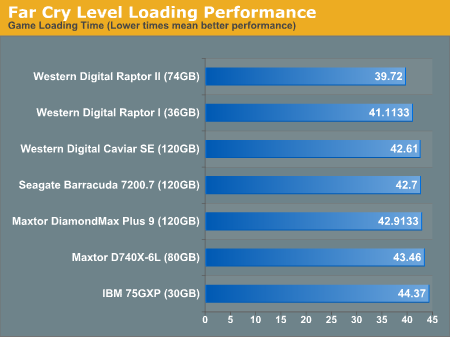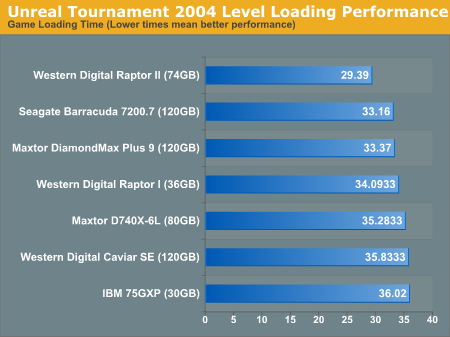Q2 2004 Desktop Hard Drive Comparison: WD Raptor vs the World
by Anand Lal Shimpi on June 7, 2004 12:05 AM EST- Posted in
- Storage
Game Loading Performance
One test that everyone wants to see when it comes to hard disk reviews is something game-related. For the most part, gamers agree that your hard drive isn't limiting performance while you're actually playing a game. After all, if you are swapping to disk a lot, then your gaming experience is going to be pretty poor, regardless of how fast your disk is. But what is important and very noticeable when it comes to disk performance in games are loading times.
Today's games have arguably some of the worst loading times ever, thanks to extremely large artwork, levels and other game data that must be loaded before game play can begin. Games also provide a very tangible and perceivable platform for hard disk performance comparison; while even Winstone scores may be difficult to relate to, everyone knows what waiting longer feels like.
For our game loading tests, we used two games: Far Cry and Unreal Tournament 2004. Both games were installed, in full, to the hard drive. We then used no-CD patches to prevent any accessing of the CD/DVD drive to skew the loading process. Both games were installed to a clean drive without anything else present on the drive (the OS is located on a separate drive).
Our Far Cry test consists of starting a campaign with the default difficulty level, hitting escape to skip the introductory movie and beginning the stop watch timer at first sight of the loading screen. The stop watch timer is stopped as soon as the loading screen disappears. The test is repeated three times with the final score reported being an average of the three. In order to avoid the effects of caching, we reboot between runs. All times are reported in seconds, lower scores obviously being better.

The benefits of a 10,000RPM spindle speed are not much when just looking at the first generation Raptor, but the new Raptor manages to offer a 6% performance advantage even over the current generation 7200RPM 8MB cache drives.
Our Unreal Tournament 2004 test uses the full version of the game and leaves all settings on defaults. After launching the game, we select Instant Action from the menu, choose Assault mode and select the Robot Factory level. The stop watch timer is started right after the Play button is clicked, and stopped when the loading screen disappears. The test is repeated three times with the final score reported being an average of the three. In order to avoid the effects of caching, we reboot between runs. All times are reported in seconds, lower scores obviously being better.

The UT test shows similar standings (although there is a bit of swapping amongst the 7200RPM 8MB cache contenders), but the 2nd generation Raptor extends its lead over its predecessor significantly. The first generation Raptor is even slightly outpaced by Seagate's 7200.7 series.










50 Comments
View All Comments
SignalPST - Monday, June 7, 2004 - link
Great review, I must say. But one thing that would certainly interest alot of people including myself would be using RAID. We know that using multiple hard drives in a RAID array is very popular among gamers and almost every motherboard out now supports RAID as well. I'm sure it'll be quite interesting to see 4 of 74GB Raptors in RAID 0 in future reviews! It would also be interesting to see the different effects of stripe sizes configurations.Doormat - Monday, June 7, 2004 - link
What about putting some meta-data in there? Like current street price, length of warranty, etc. Also temperature would be nice.I'd kinda like to see some RAID tests too, I'm looking at RAID 5 for a bunch big drives for a video on demand system.
Speaking of, a big-drive comparison would be cool too. Where's that hitachi 400GB drive they announced a while ago?
Murst - Monday, June 7, 2004 - link
Hmm,well, I'm pretty sure that there should be a significant difference in system performance when your system runs out of RAM. When virtual memory takes over, I have seen the performance of my computer drop significantly. I was hoping that a benchmark could be made showing just how large of a difference could be seen when virtual memory is a significant source of data for program execution. There should be a noticable difference in this performance between different drives.
Also, it would be interesting to know if the file system on a drive makes a difference in performance. I have a feeling that if it does, it would be unnoticable, but nevertheless, unless its tested, we would never know for sure. I don't neccessairly mean the type of file system, either. Just as RAM can have different latency settings, so can a hard drive have different block sizes (and optimal block sizes).
Again, I'm not positive if this would make a difference in performance, but I'm just trying to think of practical tests for hard drive performance.
Anand Lal Shimpi - Monday, June 7, 2004 - link
Murst,Sorry, the last response must've been posted at the same time as yours :)
Both the Winstone and SYSMark tests use multiple applications running at the same time, but I do understand the point you're trying to make.
We do have a synthetic test that shows the benefit of defragging a hard drive, but I have yet to do significant investigation in to how that affects performance between drives other than it reduces it.
Take care,
Anand
Anand Lal Shimpi - Monday, June 7, 2004 - link
Must,The drives being tested are secondary drives only for the game loading tests and the theoretical IPEAK tests. The remaining Winstone and SYSMark tests all use the drive as the only drive in the system.
Take care,
Anand
Murst - Monday, June 7, 2004 - link
Hmm... let me clarify that. I believe that all of your tests were probably ran with no other programs executing. It would be interesting to see the difference in performance when a lot of page swapping is occurring (ie, fill up the page table by executing other programs and then run a benchmark).Oh, and I just thought of another issue... why not have a benchmark which evaluates a drop in performance of a drive with data that is, say, 60% fragmented as compared to mostly unfragmented data.
Murst - Monday, June 7, 2004 - link
Its nice to see a hard drive comparison. I will be building a new comp soon and I always wondered if I'd see a difference between drives.I do, however, have one concern. It seems like the drives you used were secondary drives in the system, with the operating system working off a different drive. I have always assumed that the largest benefit of choosing a very fast drive was to minimize the access and read times of a page fault (as I generally do not spend much time at all waiting for something to load). It would seem that none of your tests take this into consideration.
Thanks
Anand Lal Shimpi - Monday, June 7, 2004 - link
#1 - You're correct, the mentions of command queuing were leftover from some early tests on a new SATA controller with support for the feature. Those tests didn't make it into the article, and I've updated it accordingly.Take care,
Anand
jliechty - Monday, June 7, 2004 - link
#1 - I was under that assumption also. I do recall hearing of a controller chip that supported TCQ being in the works (or perhaps already available), but the question remains whether that chip has been put in any controllers that are on the market at this time?Anyway, I'm glad that my preciousss... er... my Raptor didn't do too badly, though for what I do I probably could have kept my old WD Caviar Special Edition and not noticed much of a difference, except for my wallet being heavier. :-(
RyanVM - Monday, June 7, 2004 - link
Doesn't the WD74GD require a controller which supports command queuing in order for that feature to be of actual use? And I was under the impression that no current SATA controllers support that function.